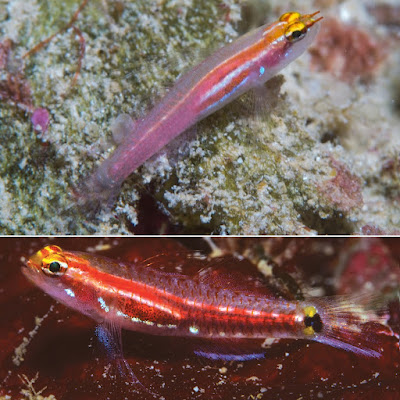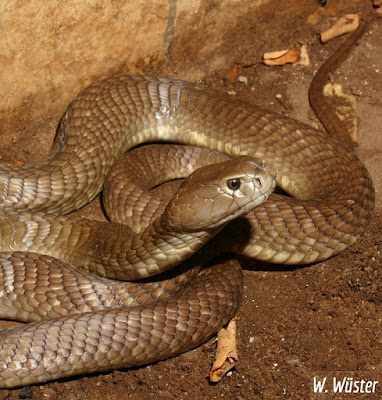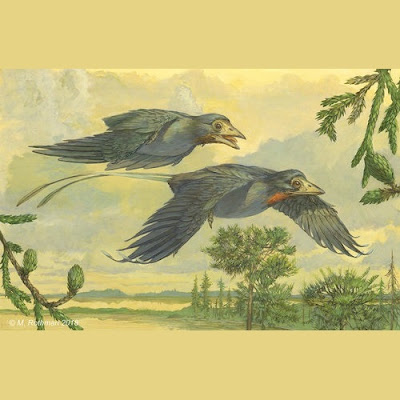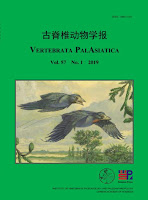[Most Recent Entries] [Calendar View]
Wednesday, April 3rd, 2019
| Time | Event | ||||
| 1:47a | [Ichthyology • 2019] Eviota gunawanae • A New Microendemic Dwarfgoby (Teleostei: Gobiidae) from the Fakfak Peninsula, West Papua, Indonesia
Abstract A new species of dwarfgoby, Eviota gunawanae, with a cephalic sensory-canal pore pattern lacking only the IT and NA pores and with the AITO pore positioned far forward and opening anteriorly, is described from the Fakfak Peninsula in the Bird’s Head Seascape of western New Guinea, West Papua Province, Indonesia. It has a dorsal/anal-fin-ray formula of 8/7, 16 unbranched pectoral-fin rays, the fifth pelvic-fin ray present, very long anterior tubular nares, a distinctive double black spot at the caudal-fin base, and no narrow horizontal line of melanophores crossing the pectoral-fin base. In life, it has a maroon stripe down the midline of the body, with elongate white spots above it posteriorly and two white lines over the abdomen. E. gunawanae is most closely related to E. tetha. The new species appears to represent the eighth known microendemic fish species from this remote reef location in West Papua, highlighting the biodiversity conservation importance of the Fakfak Peninsula’s reefs. Key words: taxonomy, systematics, ichthyology, coral-reef fishes, gobies, endemism, microendemism, phylogenetics, Bird’s Head Seascape, conservation, Eviota tetha
Eviota gunawanae, n. sp. Greenfield, Tornabene & Erdmann Tiene’s Dwarfgoby Diagnosis. A species of Eviota with a cephalic sensory-canal pore pattern lacking only IT and NA pores and with AITO pore positioned far forward and opening anteriorly; very long anterior tubular nares; dorsal/anal-finray formula 8/7; 16 unbranched pectoral-fin rays; fifth pelvic-fin ray about 10% length of the fourth pelvic-fin ray; a black spot at caudal-fin base in two joined parts extending anteriorly past end of hypural plate; top of head with scattered melanophores, sometimes arranged in lines, but not as a single line of melanophores extending posteriorly from PITO pore back onto nape. In life, a maroon stripe down midline of body with elongate white spots above stripe posteriorly and two white lines over abdomen. Etymology. The species is named in honor of Dr. Tiene Gunawan, one of Indonesia’s foremost marine conservationists who has dedicated the past two decades to expanding the marine protected area network of West Papua and formulating policies to protect the biodiverse marine ecosystems contained therein. Dr. Gunawan also helped plan and launch the marine biodiversity survey of the Fakfak coastline that led to the discovery of this species. Distribution and habitat. Currently known only from Karas Island in the Fakfak Regency, West Papua Province, Indonesia. It is presumably more widespread along the poorly-explored Fakfak coastline, but unlikely to be found in the very well-surveyed Raja Ampat Islands to the north. The species was found in a relatively unusual deepwater-reef environment consisting of large foliose and plating corals on a gentle slope from 35–55m depth, exposed to moderate currents but otherwise protected from wave energy. David W. Greenfield, Luke Tornabene, Mark V. Erdmann and Defy N. Pada. 2019. Eviota gunawanae, A New Microendemic Dwarfgoby from the Fakfak Peninsula, West Papua, Indonesia (Teleostei: Gobiidae). Journal of the Ocean Science Foundation. 32; 57–67. DOI: 10.5281/zenodo.26167 | ||||
| 8:16a | [Herpetology • 2007] Naja ashei • Get An Eyeful of This: A New Species of Giant Spitting Cobra (Serpentes: Elapidae: Naja) from eastern and north-eastern Africa
We describe a new species of giant spitting cobra, Naja ashei sp. nov., from eastern and north-eastern Africa. The species was previously regarded as a colour phase of the black-necked spitting cobra, N. nigricollis. However, mtDNA sequence data show it to be more closely related to N. mossambica than N. nigricollis. The new species is diagnosable from all other African spitting cobras by the possession of a unique clade of mtDNA haplotypes and a combination of colour pattern and scalation characteristics. Its distribution includes the dry lowlands of northern and eastern Kenya, north-eastern Uganda, southern Ethiopia and southern Somalia. Key words: Naja ashei sp. nov., Naja nigricollis, Naja mossambica, Serpentes, Elapidae, Africa, mitochondrial DNA, phylogeny, multivariate morphometrics
Naja ashei sp. nov. Ashe’s spitting cobra Diagnosis. Naja ashei differs from all other African spitting cobras in possessing a unique clade of mtDNA haplotypes. From the data presented here, we identified 12 fixed nucleotide differences that differentiate N. ashei from the other eastern African spitting Naja. These correspond to positions 105, 169 and 315 of the ND4 sequence of the holotype (DQ897706), and to positions 60, 108, 153, 201, 348, 381, 507, 630 and 676 of the cytochrome b sequence of the same specimen (DQ897749), the diagnostic bases at these positions being C, T, G, C, G, T, T, T, A, C, T and A, respectively. Morphologically, N. ashei differs from East African N. nigricollis in a number of characters relating to adult colour pattern and scalation. In particular, its midbody and posterior ventral colour is predominantly light, with dark pigment encroaching mostly from the sides of the body (venter normally largely or entirely dark in N. nigricollis), it lacks any red, orange or pink pigment under the throat (usually pronounced in N. nigricollis), and the head is the same olive-brown colour as the rest of the body (often black above and below in East African N. nigricollis). Scalation does not provide any absolutely diagnostic characters for N. ashei, but mean scale counts and the range differ clearly from those of East African N. nigricollis (Table 4). In particular, N. ashei can be distinguished from most eastern African N. nigricollis by the combination of high ventral scale and dorsal scale row counts. Most N. ashei have over 195 ventrals and at least 21 and typically more scale rows around the neck, whereas most N. nigricollis with 195 or more ventrals have at most 21, and usually 19 or fewer scale rows around the neck, whereas higher scale row counts around the neck tend to be found in specimens with fewer ventral scales. .... Etymology. We dedicate this species to the memory of the late James Ashe (1925–2004), in recognition of his contributions to East African herpetology, of the inspiration he gave to others working on the herpetofauna of this part of the world (see Spawls, 2004), of his early recognition of the distinctiveness of the species that now bears his name, and in gratitude for his support for this work. Wolfgang Wüster and Donald G. Broadley. 2007. Get An Eyeful of This: A New Species of Giant Spitting Cobra from eastern and north-eastern Africa (Squamata: Serpentes: Elapidae: Naja). Zootaxa. 1532(1); 51–68. | ||||
| 10:14a | [PaleoOrnithology • 2019] A Taxonomical Revision of the Confuciusornithiformes (Aves: Pygostylia)
Abstract The Confuciusornithiformes is a basal clade of Early Cretaceous birds that includes the oldest and most basal birds with a toothless beak and an abbreviated bony tail. Over the last two decades, thousands of specimens have been collected, more than for any other group of Mesozoic birds or non-avian dinosaurs. Ten species separated into four genera have been erected with limited taxonomic phylogenetic scrutiny. Here, we perform a comparative study of these ten species, and demonstrate that most of these taxa were originally diagnosed by characters that prove to be either preservational artifacts, intraspecific variations, subject to ontogenetic variation, or widely distributed among the Confuciusornithiformes or a more phylogenetically inclusive group. Our results suggest that ‘Confuciusornis suniae’, ‘C. feducciai’, ‘Jinzhouornis yixianensis’, ‘J. zhangjiyingia’, and ‘C. jianchangensis’ are all junior synonyms of C. sanctus. ‘C. chuonzhous’ lacks autapomorphies of C. sanctus and is referred to Confuciusornithiformes incertae sedis. Our taxonomic reappraisal of published materials indicates that the Confuciusornithiformes consists of one family, three genera, and four species: Confuciusornis sanctus, C. dui, Changchengornis hengdaoziensis, and Eoconfuciusornis zhengi, for which we provide revised diagnoses. Key words: Cretaceous, Aves, Confuciusornithiformes, Confuciusornis, taxonomy, phylogeny
Conclusion: Reexamination of all currently recognized species of the Confuciusornithiformes supports widespread conjecture in the literature that most taxa are invalid due to inadequate diagnoses, based on characters that are either widely distributed among confuciusornithiforms, taphonomic artifacts, points of intraspecific variation, or simply misinterpreted. ‘C. feducciai’, ‘C. suniae’, ‘J. yixianensis’, ‘J. zhangjiyingia’, and ‘C. jianchangensis’ should be regarded as junior synonyms of C. sanctus. ‘C. chuonzhous’ is a nomen dubium and should be referred to Confuciusornithiformes incertae sedis. The recently described BMNHC-PH870 is certainly a confuciusornithiform, but cannot be adequately diagnosed at this time without the discovery of more material to clarify potential ontogenetic differences between this specimen and other confuciusornithiforms from the Huajiying Formation. Therefore, BMNHC-PH870 is regarded as Confuciusornithiformes incertae sedis. Under the present taxonomic revision, the Confuciusornithiformes consists of one family, three genera, and four species, C. sanctus, C. dui, Ch. hengdaoziensis, and E. zhengi. The actual diversity of the Confuciusornithiformes is in all probability higher. However, the identification of new species needs to be well supported by valid diagnostic features that clearly distinguish the putative new taxa from existing confuciusornithiforms. This taxonomic revision clarifies the current diversity and provides a launching point for future studies attempting to tackle the thousands of unstudied confuciusornithiforms in collections throughout China. Wang Min, Jingmai O’Connor and Zhou Zhong-He. 2019. A Taxonomical Revision of the Confuciusornithiformes (Aves: Pygostylia). Vertebrata PalAsiatica. 57(1): 1–37. ivpp.cas.cn/cbw/gjzdwxb/xbwzxz/201811/t2 |
| << Previous Day |
2019/04/03 [Calendar] |
Next Day >> |








